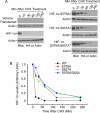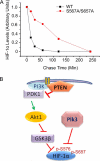Plk3 functions as an essential component of the hypoxia regulatory pathway by direct phosphorylation of HIF-1alpha
- PMID: 20889502
- PMCID: PMC2998109
- DOI: 10.1074/jbc.M110.160325
Plk3 functions as an essential component of the hypoxia regulatory pathway by direct phosphorylation of HIF-1alpha
Abstract
Polo-like kinase 3 (Plk3) plays an important role in the regulation of cell cycle progression and stress responses. Plk3 also has a tumor-suppressing activity as aging PLK3-null mice develop tumors in multiple organs. The growth of highly vascularized tumors in PLK3-null mice suggests a role for Plk3 in angiogenesis and cellular responses to hypoxia. By studying primary isogenic murine embryonic fibroblasts, we tested the hypothesis that Plk3 functions as a component in the hypoxia signaling pathway. PLK3(-/-) murine embryonic fibroblasts contained an enhanced level of HIF-1α under hypoxic conditions. Immunoprecipitation and pulldown analyses revealed that Plk3 physically interacted with HIF-1α under hypoxia. Purified recombinant Plk3, but not a kinase-defective mutant, phosphorylated HIF-1α in vitro, resulting in a major mobility shift. Mass spectrometry identified two unique serine residues that were phosphorylated by Plk3. Moreover, ectopic expression followed by cycloheximide or pulse-chase treatment demonstrated that phospho-mutants exhibited a much longer half-life than the wild-type counterpart, strongly suggesting that Plk3 directly regulates HIF-1α stability in vivo. Combined, our study identifies Plk3 as a new and essential player in the regulation of the hypoxia signaling pathway.
Figures






Similar articles
-
Roles of Polo-like kinase 3 in suppressing tumor angiogenesis.Exp Hematol Oncol. 2012 Apr 18;1(1):5. doi: 10.1186/2162-3619-1-5. Exp Hematol Oncol. 2012. PMID: 23210979 Free PMC article.
-
Polo-like kinase 3, hypoxic responses, and tumorigenesis.Cell Cycle. 2017;16(21):2032-2036. doi: 10.1080/15384101.2017.1373224. Epub 2017 Sep 21. Cell Cycle. 2017. PMID: 28857653 Free PMC article. Review.
-
Polo-like kinase 3 functions as a tumor suppressor and is a negative regulator of hypoxia-inducible factor-1 alpha under hypoxic conditions.Cancer Res. 2008 Jun 1;68(11):4077-85. doi: 10.1158/0008-5472.CAN-07-6182. Cancer Res. 2008. PMID: 18519666 Free PMC article.
-
Regulation of PTEN stability and activity by Plk3.J Biol Chem. 2010 Dec 17;285(51):39935-42. doi: 10.1074/jbc.M110.166462. Epub 2010 Oct 12. J Biol Chem. 2010. PMID: 20940307 Free PMC article.
-
Activation of Polo-like kinase 3 by hypoxic stresses.J Biol Chem. 2008 Sep 19;283(38):25928-35. doi: 10.1074/jbc.M801326200. Epub 2008 Jul 23. J Biol Chem. 2008. PMID: 18650425 Free PMC article.
Cited by
-
Polo-like kinase 2 regulates angiogenic sprouting and blood vessel development.Dev Biol. 2015 Aug 15;404(2):49-60. doi: 10.1016/j.ydbio.2015.05.011. Epub 2015 May 22. Dev Biol. 2015. PMID: 26004360 Free PMC article.
-
Basic Biology of Hypoxic Responses Mediated by the Transcription Factor HIFs and its Implication for Medicine.Biomedicines. 2020 Feb 13;8(2):32. doi: 10.3390/biomedicines8020032. Biomedicines. 2020. PMID: 32069878 Free PMC article. Review.
-
Focus on PTEN Regulation.Front Oncol. 2015 Jul 27;5:166. doi: 10.3389/fonc.2015.00166. eCollection 2015. Front Oncol. 2015. PMID: 26284192 Free PMC article. Review.
-
Roles of Polo-like kinase 3 in suppressing tumor angiogenesis.Exp Hematol Oncol. 2012 Apr 18;1(1):5. doi: 10.1186/2162-3619-1-5. Exp Hematol Oncol. 2012. PMID: 23210979 Free PMC article.
-
Polo-like kinase 3 inhibits glucose metabolism in colorectal cancer by targeting HSP90/STAT3/HK2 signaling.J Exp Clin Cancer Res. 2019 Oct 26;38(1):426. doi: 10.1186/s13046-019-1418-2. J Exp Clin Cancer Res. 2019. PMID: 31655629 Free PMC article.
References
-
- Barr F. A., Silljé H. H., Nigg E. A. (2004) Nat. Rev. Mol. Cell Biol. 5, 429–440 - PubMed
-
- Dai W. (2005) Oncogene 24, 214–216 - PubMed
-
- Zimmerman W. C., Erikson R. L. (2007) Cell Cycle 6, 1314–1318 - PubMed
-
- Xie S., Wang Q., Wu H., Cogswell J., Lu L., Jhanwar-Uniyal M., Dai W. (2001) J. Biol. Chem. 276, 36194–36199 - PubMed
Publication types
MeSH terms
Substances
Grants and funding
LinkOut - more resources
Full Text Sources
Molecular Biology Databases

